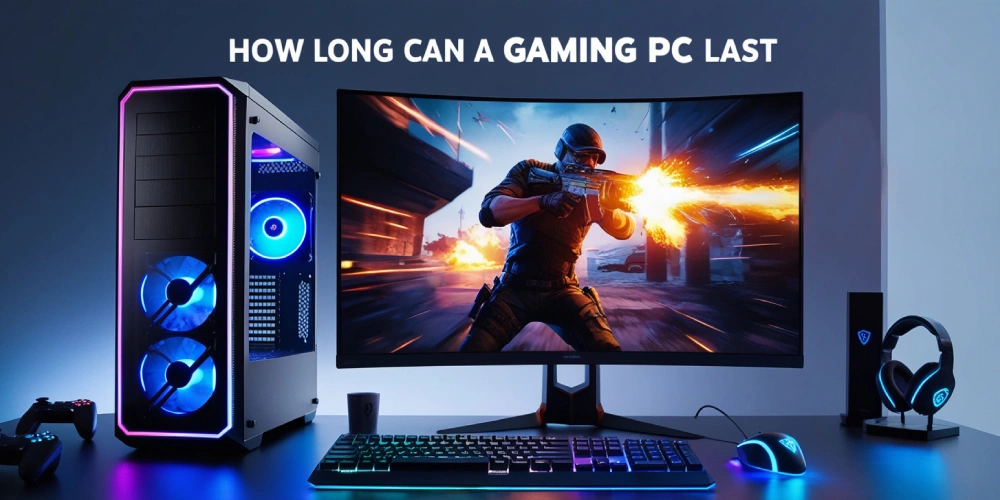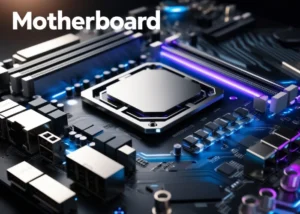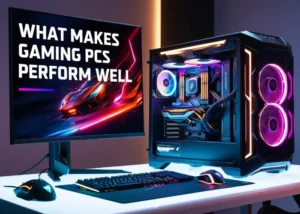No matter if you purchase or build your gaming PC from scratch, its lifespan depends on many variables, such as hardware quality and frequency of usage, care taken to protect it, and how often maintenance checks are performed. There is no one-size-fits-all answer; some players might get 5 to 7 years without needing any replacement or upgrades, while others might extend that up to over 10-12 years depending on individual players and maintenance practices; it all comes down to you and how frequently maintenance checks take place; so if PC gaming is something you enjoy make sure you do your maintenance checks regularly! Let’s talk about how long a gaming PC lasts!
How long a gaming PC lasts:
Gaming PCs typically last between 7-10 years, depending on how well they’re cared for and whether their tech works flawlessly. However, that doesn’t refer to when specific components start wearing out; that usually only happens every 3 to 4 years. Most computer hardware is made according to industry-wide standards, yet external factors can affect how long gaming PC parts last over time. Because each part of your game PC plays an essential role in its longevity, let’s examine each component to assess its lifespan and what factors influence its lifespan.
The most significant consideration:
These are called CPUs, and they last between 6 and 10 years. As it’s an integral component of an operations system, its operation often receives the most significant consideration.
CPU:
CPU temperatures typically range between 30 and 90 degrees Celsius before they return to room temperature, where they remain. While this doesn’t cause immediate harm, over time, silicon cells that make up the CPU start breaking down after thousands of thermal cycles due to large amounts of electricity used by it, which in turn produces heat. As stress puts more strain on it, more damage may be sustained; however, many modern CPUs come equipped with safeguards that protect against significant damage occurring. Some of these defenses are taken away when you overclock, though, so the extra speed almost always comes at the cost of a longer life. If your CPU has been seriously damaged, you may see blue screens or have random shutdowns when you use it a lot. You should call support to get this fixed.
The GPU:
When it comes to longevity, the Graphics Processing Unit (GPU) is comparable to the central processing unit (CPU) in that it can live anywhere from six to ten years. On conventional personal computers, the graphics processing unit (GPU) is integrated into the central processing unit (CPU) silicon and shares power and memory resources with the CPU. Gaming computers feature GPUs housed on separate printed circuit boards (PCBs) that plug directly into their motherboards, each equipped with power and memory resources of its own.
Graphics card:
As graphics cards consume an enormous amount of power, they usually feature robust heatsinks with two to three fans to maintain optimal conditions and ensure everything remains relaxed and comfortable for their user. Graphics cards, on the other hand, will function at temperatures ranging from 30 to 80 degrees Celsius, and newer GPUs will automatically adjust their performance in accordance with the ambient temperature at which they are operating. The performance of a graphics card that operates at 60 degrees Celsius while playing a game will be superior to that of an identical card operating at 80 degrees Celsius. Like a central processing unit (CPU), a graphics processing unit (GPU) can be damaged by high temperatures and general degradation that might occur over several years.
Motherboard:
Since motherboards are one of the most robust components in any computer system, their lifespan directly correlates to that of its central processing unit (CPU), which could range anywhere between six to eight years before BIOS support expires and support is no longer provided. Motherboard quality can have an effect on the performance of the central processing unit (CPU), the mainstay of any computer. It is the motherboard’s job to draw power from its source and distribute it accordingly to both CPUs and random access memory (RAM).In the event that a motherboard is unable to meet the power requirements of the central processing unit (CPU), the CPU will be forced to reduce its performance.
VRM:
The VRM will be the most worn part on the motherboard over some time. All the electricity from the power source goes to the CPU, and these components are responsible for filtering and distributing said power. They are rated to function at temperatures as high as 105 degrees Celsius or even 125 degrees Celsius. This is due to the fact that they do not generate a significant amount of heat, which is the reason why they often merely have a metal heatsink attached to them and do not require an active fan.
RAM:
Random Access Memory (RAM) is made up of units that fit into slots on the motherboard. Because they depend on how well they work with the motherboard. RAM can last anywhere from 6 to 8 years or until the motherboard dies. When they are put into the motherboard, clips hold them in place so they don’t fall out. However, like all other parts, these use silicon transistors. Which means that heat and electrical stress can damage them over time.
Drives for storage:
Solid State Drives (SSDs) and Hard Disk Drives (HDDs) hold all the data you save . And want to keep even when you turn the computer off and on again. Most of the time, these hard drives last between 5 and 10 years. Manufacturer warranties on most drives last between 2 and 5 years, based on the quality and series of the drive. They cover up to 50TB of data written to them each year.
If you treat your PC well enough, it should last for 7–10 years without problems. You should clean the computer once a month for about 5–10 minutes . And then again recheck the fans to make sure they don’t gather too much dust on them. Think of heat as the enemy of your PC’s lifetime. Lower temperatures mean longer-lasting computers.
What Makes Gaming PCs Perform Well
PCs continue to advance every year as new parts become available and improve the overall speed. What this means is that, even with the latest equipment. A gaming desktop may last ten years before reaching total capacity and ceasing to function optimally. This doesn’t necessarily mean one is no longer able to access higher and latest levels of games – instead. It just means their performance may reduce significantly over time.
How long does playing pre-built games take?
There are a number of reasons pre-assembled gaming systems tend to last much longer than the ones assembled at home. Apex Gaming PCs are often designed to keep longevity in mind by inspecting for broken parts. Improving their quality control measures, and adjusting BIOS settings when necessary to ensure their longevity.
In addition to the build and quality control processes, the RMA department has access to older hardware. That can be used to replace broken parts up to three years after the hardware was first released. If the manufacturer stops supporting those parts, they can also offer other choices.
Is it true that gaming PCs last longer than consoles?
In terms of support for constituted service, PCs are better than their console peers. Over 20 years of standard connections and compatibility standards for gamers and producers mean that standard parts work with them. Both could last a long time if they are correctly cared for. However, if you want to learn how to use a computer. A PC is a better choice because it has more engaging media.
In short:
How long can a gaming pc That depends on how well you take care of it . And how often you update its parts? A gaming PC can last anywhere from two to five years. Of course, the quality of the parts you use also affects how long your game PC lasts. Purchase high-grade parts and conduct regular maintenance to extend the lifespan of your gaming PC as much as possible. Every year, new technology emerges, making it tempting to acquire every bit of gear possible.



